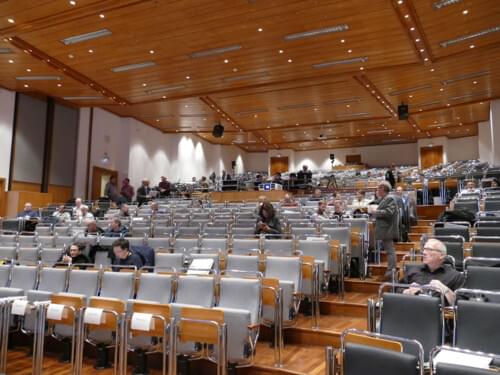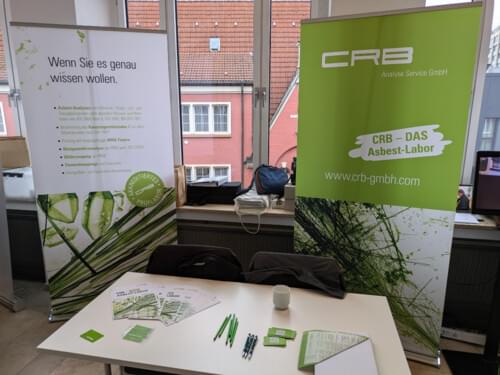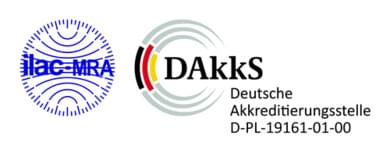Follow-up report: Asbestos and other building pollutants forum 2024

In November, we again met with representatives of the asbestos industry at the Asbestos Forum at the Haus der Technik (HDT) in Essen. In addition to exciting discussions at our CRB information stand, we naturally listened to various specialist presentations. The latest developments in the field of diagnostics and remediation of building contaminants were discussed. For all those who were unable to attend or would like to review the event, we have summarized some of the main points of the conference here:
Current developments on the subject of asbestos in Austria
Austria is also facing the problem of getting rid of asbestos. In the future, greater attention will be paid to sustainability and the circular economy. Waste with an asbestos content of more than 0.1% is considered hazardous and must be treated separately. For asbestos contents up to 0.1 %, an emission measurement or a risk assessment by means of limit value comparison measurements in accordance with the Limit Values Ordinance or TRGS 910 is required. If no hazardous emissions are to be expected, special treatment as asbestos-containing waste is not required.
About the situation in Austria, the following topics were also discussed at the Asbestos 2024 Forum:
- Recycling: For plasters, fillers, and tile adhesives with less than 0.1% asbestos by mass, a limit value of 0.008% asbestos by mass applies. Below this, recycling is possible.
- Spacers made of asbestos cement: Removal of these is recommended, but is often not completely possible. For demolition work with these spacers, a risk analysis is necessary and the release of dust must be minimized.
- Sampling and determination of asbestos: As in Germany, the methods VDI 3866 Sheet 1, VDI 3876, and VDI 6202 Sheet 3 as well as ISO 22262-1 apply for sampling. IFA (BIA) 7487, VDI 3866 Sheet 5 with Annex B, VDI 3876, and ISO 2262-2 apply for the determination methods.
- Artificial mineral fibers: To identify hazardous artificial mineral fibers, the length-weighted mean geometric diameter minus twice the geometric standard error (LGWMD-2SE) is used - in accordance with Regulation (EC) 1272/2008 (CLP Regulation).
- Landfill Directive: The recycling of construction waste is to be promoted under the EU Landfill Directive and from 2026 the landfilling of certain recyclable waste, such as gypsum blocks and gypsum plasterboard, will be prohibited.
Current asbestos and building pollutant situation in Switzerland
In Switzerland, the EKAS Guideline 6503 (the Swiss equivalent of TRGS 519) is currently being revised. There is also a new factsheet no. 33105 “Asbestos removal - work plan for asbestos removal companies” and new factsheets from the Swiss National Accident Insurance Fund (SUVA) for handling PCBs and PAHs. A current checklist for building permit authorities is intended to ensure the quality of expert reports.
The transitional period for building pollutant diagnosticians without an examination ended in 2023, leading to a shortage of specialists. PFAS (perfluorinated and polyfluorinated alkyl compounds), which are frequently found in building materials and for which there is a lack of guidelines (not only in Switzerland), were also discussed.
Other Swiss topics at a glance:
- Covert sample shipment: the covert proficiency test took into account new requirements for the determination of asbestos fibers in accordance with the FACH position paper. The results were mixed, some laboratories lost recognition, especially for acoustic panels there were often false negative results.
- EKAS Guideline 6503: Among other things, there is now an obligation to require compliance with this EKAS Guideline in the work contract. In addition, a leak test of breathing apparatus is required before each use.
- Ban on blasting methods for asbestos removal: The ban makes the removal of asbestos-containing coatings more difficult. Water blasting methods could replace dry blasting methods, but have potential side effects such as contamination of the underlying structures.
Current asbestos and building pollutant issues in Germany
At the Asbestos Forum, a somewhat worrying trend in recognized asbestos-related deaths was discussed: Despite the more than 30-year ban on asbestos, there has been no significant decline. However, a slightly negative trend is discernible.

Hazardous Substances Ordinance (GefStoffV) & Co.
The amended Hazardous Substances Ordinance still no longer includes builder liability (as was the case in the draft bill). Depending on the direction of travel, some see this as a success, others as a black day for occupational health and safety.
To strengthen the circular economy, the European Commission has updated the EU protocol for the management of construction and demolition waste, including guidelines for audits before the demolition and renovation of buildings.
In 2024, RAL Gütegemeinschaft Schadstoffsanierung e.V. was also added to the RAL family with the RAL quality mark 540 “Remediation of pollutants in existing buildings and technical installations”.
In May, LAGA M 41 “Enforcement aid for implementing the waste legislation requirements of the EU POP Regulation - principles and areas of application” was published (POP = persistent organic pollutants).
In addition, the guideline VDI 6210 Sheet 1 Demolition of structural and technical facilities was further revised - taking into account the basic requirements of DIN SPEC 91484 on pre-demolition audits. The revision of the VDI 6202 series of guidelines is also underway.
Specialist databases on pollutants and asbestos
The building pollutants database is still in its initial phase, while the asbestos database is more advanced with around 810 objects from over 600 projects and a focus on southern Germany. In addition, a database on PCBs and CPs is being set up in collaboration with the University of Karlsruhe, for which further partners and data are still required.
Current topics and developments in fiber measurement technology
Revision of VDI 3492
VDI 3492 has been revised to keep pace with the latest developments. Among other things, the measurement planning has been revised to ensure a uniform approach, which will lead to more measuring points and greater significance in some scenarios. Usage simulation has been made more practical and fiber identification has been fundamentally revised, including digital analysis.
Thin fibers - EU directive on asbestos in the workplace
The EU plans to reduce the limit value for asbestos exposure in the workplace from 100,000 fibers/m³ to 10,000 fibers/m³ from 21.12.2025. After a 6-year transitional period, two options remain for analysis:
- If the so-called thin fibers (with a diameter of less than 0.2 µm) are measured, the limit value can remain at 10,000 fibers/m³.
- If these thin fibers are not measured, the limit value drops to 2,000 fibers/m³.
Although asbestos fibers with a diameter of less than 0.2 µm are currently recorded, they are not included in the result.
This raises several questions:
- How toxicologically relevant are the thin fibers with a diameter of less than 0.2 µm?
- Are these thin fibers really more dangerous than the rigid, stiff fibers?
- What is the relationship between fiber diameter and stiffness?
- And does this apply to both chrysotile and amphibole asbestos?
The challenge for analytics
The problem is to find and correctly identify thin fibers, which depends on the quality of the microscope and the experience of the analyst. The time and cost of analysis will increase. Higher magnification (approx. 6,000x) will be required, which may require new, better equipment. Today's electron-dispersive analysis reaches its limits with very thin fibers, especially in the vicinity of foreign particles.
The reduction of the limit value to 2,000 fibers/m³ requires a reassessment of the procedures and adaptation of the protective equipment. This could promote the use of the transmission electron microscope, as it can detect very thin fibers and identify them more easily.
Occupational health and safety when handling asbestos

A lot has happened recently concerning asbestos exposure in occupational safety. The new Hazardous Substances Ordinance contains, among other things, risk-based action plans for activities involving carcinogenic hazardous substances such as asbestos. These are based on risk-based concentration values that cover three risk areas (low, medium, and high risk). It is the employer's responsibility to determine the exposure and the risk area. Exceptions to the restrictions on activities involving asbestos include certain functional maintenance activities as part of the ongoing use of a building, as long as there is no high risk with more than 100,000 fibers/m³.
Here are a few examples of asbestos exposure during activities in existing buildings:
- Drilling tile without extraction: 36,000 fibers/m³
- Chipping off a single tile: 77,000 fibers/m³
- Grinding off adhesive 1,000,000 fibers/m³
Considerable fiber exposures can therefore occur even with relatively minor activities. Under certain circumstances, the acceptable concentration can be exceeded even with only low exposures. Only consistent low-dust work and low-emission processes, if available, can help here.
Conclusion on the Asbestos 2024 Forum
Once again, we had a lot of fun discussing asbestos analysis, building pollutants, and the like and keeping up to date with the latest developments in the DACH region and Europe. Attending the event was particularly worthwhile for the personal exchange of experiences with other experts and specialists.
For even more detailed insights into the content of the presentations at the Asbestos 2024 Forum, we recommend the detailed blog entry by our colleague Dr. Gunnar Ries. There you can also read about asbestos in bridges, tunnels, and lock systems as well as the sense or nonsense of grid fiber bonding, the ATV DIN 18448, and the topic of air exchange: https://scilogs.spektrum.de/mente-et-malleo/forum-asbest-und-andere-gebaeudeschadstoffe-2024/
We hope to be back at the next Asbestos Forum on November 6 and 7, 2025. But before that, we will welcome you next at DCONex on January 28 and 29, 2025 in Münster.


